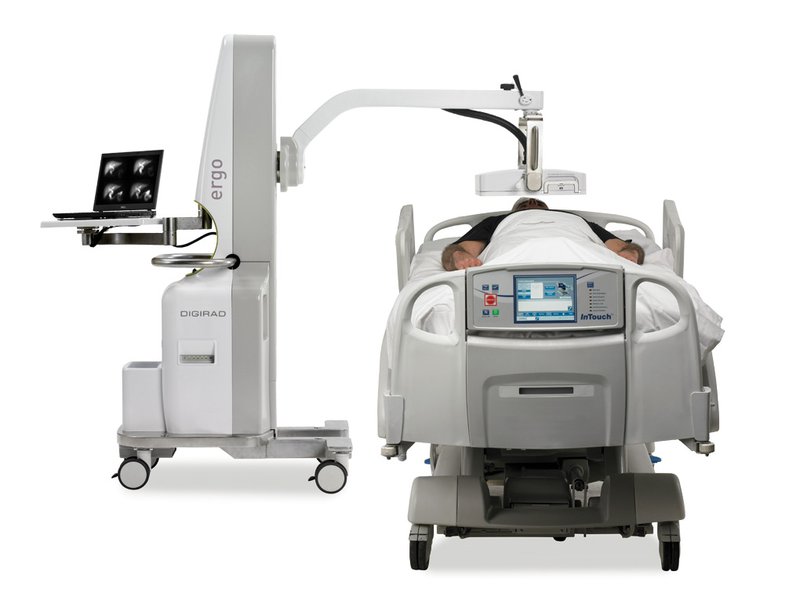Advancements in imaging technology have undoubtedly enhanced diagnostics and accuracy. However, there are still systemic challenges radiologists and clinicians face that impact the quality of patient care. These obstacles and challenges have led to an inevitable decrease in volume in nuclear medicine departments.
How can we change this?
Point-of-care imaging is giving radiology departments the ability to address challenges head-on with expanded service options and improved patient care. Innovations around point-of-care imaging are leading to increased volume and greater patient satisfaction.
In this article, we will explore the specific benefits of point-of-care imaging that are shaping radiology departments.
How Point-of-Care Testing Is Shaping Radiology
There are obvious benefits in implementing portable radiology technology in hospital settings. By harnessing its potential, you can improve patient satisfaction, quality of care, and even hospital revenue.
Impacting Studies
Adding point-of-care (POC) testing to your departments can significantly increase the number of studies you can perform.
Without portable imaging, there are certain settings where studies are too risky or complicated to perform. In contrast, POC tests allow you to bring imaging to the patient, which can allow for successful and transformative clinical research that can’t be performed outside of the hospital.
This unique opportunity is coupled with increased efficiency, as POC technology can be completed quickly and requires no patient transport. This can significantly boost not only the potential for studies but the amount you can perform in a given time period.
Many nuclear medicine departments using POC imaging have reported an increased number of studies in:
- Brain Viability
- Intraoperative Imaging
- Lymphoscintigraphy
- GI Bleed
- Lung Perfusion
- HIDA
- MUGA
- Bone Flow/Blood Pool
Improving Surgical Outcomes in the OR
Improved surgical outcomes can enhance patient quality of care and prevent readmission. By providing significant intraoperative benefits, POC imaging is shaping surgery in the OR.
The Digirad Ergo was highlighted for its success in this perspective. An article published by the Journal of Pediatric Surgery highlighted its ability to enhance operation room success. This is attributed to its portability and high-quality image delivery, both of which are key features.
Reduced Time Under Anesthesia
Increased time under anesthesia is a risk factor for complication in surgery. Reducing this time can reduce overall risk and improve patient outcome.
By using portable imaging technology, patients can be anesthetized in the OR for both imaging procedures and surgery. As a result, patients spend less time under anesthesia and don’t require transport to the surgery room, leading to a much safer hospital experience.
Real-Time Results
Portable imaging devices allow for full confirmation of surgery success. By confirming lesion and tumor removal and identification of remaining or unknown masses, surgical outcomes are improved. This means bolstered patient satisfaction and less chance of readmission.
Take, for example, one case study of a thyroid cancer patient that showed significant residual thyroid tissue after a full thyroidectomy. The patient required lymph node removal after a follow-up study. During surgery, using point-of-care tests, surgeons were able to identify that initial surgery didn’t successfully remove the lymph node. With a second attempt, they were able to remove the node and confirm its full removal using portable imaging technology.
Reducing Risk Factors Associated with Patient Transport
Patient transport is a significant risk factor in hospital settings. According to one review, some risks associated with patient transport are:
- Potential for infectious exposure
- Ventilator-acquired pneumonia
- Hypoxemia
- Pulmonary complications
- Tachycardia
- Cardiac arrest
- Arrhythmia
- Equipment dislodgement
- Interruption of therapy or care
Critically ill patients are at the highest risk in these cases and transporting them can be extremely risky. Often, the risk of transporting the patient may even outweigh the benefits. This presents a dilemma for clinicians in the hospital.
But, at times, transportation of patients for imaging is desperately needed. In these cases, patients often require devices like oxygen and a significant labor requirement for transit. Therapists, nurses, transporters, and, sometimes, even more staff must be present for successful intrahospital patient transport.
To truly improve patient care, reducing risks associated with transport is critical. Portable imaging can significantly reduce this risk.
In contrast to labor-laden patient transport, portable imaging only requires one employee: a Nuclear Medicine Technician (NMT). Best of all, there is absolutely no patient transport necessary. This not only removes the risks associated with patient transport but cuts down on the need for expensive labor that is absolutely essential to the process.

Point-of-Care Imaging and Brain Death Studies
Portable imaging technology allows for earlier and less traumatic identification of brain death.
By accomplishing this, point-of-care testing prevents non-viable patients from using expensive life support devices for an unnecessary amount of time. In these cases, portable imaging can decrease expenses.
Proper identification of brain death is also essential for facilitating organ harvesting. Portable imaging can speed and simplify this process.
Point-of-Care Imaging Is the Future of Nuclear Medicine
Implementing portable imaging technologies into hospital settings can provide a significant benefit. This is centered around improved patient care and value by reducing risks associated with transport, increasing studies, and improving surgical outcomes in the operating room.
Point-of-care equipment like the Ergo from Digirad can help expand services in the OR, ER, and ICU. The Ergo is the premier multi-purpose imaging machine, and offers the following advantages:
- Portability and versatility: Compact and highly versatile, this machine can help expand hospital services.
- Ease of use: The sleek and forward-thinking design of the Ergo makes it easy on patients to perform imaging whether they are sitting up or laying down.
- Solid-state technology: The Ergo is engineered for superior imaging quality.
Are you a health professional interested in employing point-of-care imaging? At Digirad, we deliver advanced nuclear and diagnostic solutions, including portable imaging devices. Our services are scalable to suit the healthcare spectrum, ranging from a single office practitioner to a large hospital system.
For more information on how Digirad can make your patient care convenient, contact us today.




